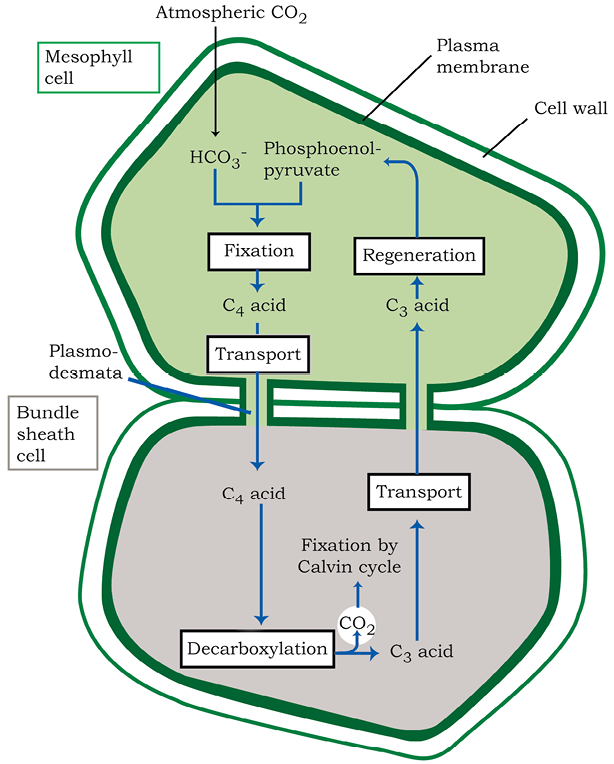Plants that are adapted to dry tropical regions have the C4 pathway mentioned earlier. Though these plants have the C4 oxaloacetic acid as the first CO2 fixation product they use the C3 pathway or the Calvin cycle as the main biosynthetic pathway. Then, in what way are they different from C3 plants? This is a question that you may reasonably ask.
C4 plants are special: They have a special type of leaf anatomy, they tolerate higher temperatures, they show a response to high light intensities, they lack a process called photorespiration and have greater productivity of biomass. Let us understand these one by one.

The particularly large cells around the vascular bundles of the C4 plants are called bundle sheath cells, and the leaves which have such anatomy are said to have ‘Kranz’ anatomy. ‘Kranz’ means ‘wreath’ and is a reflection of the arrangement of cells. The bundle sheath cells may form several layers around the vascular bundles; they are characterised by having a large number of chloroplasts, thick walls impervious to gaseous exchange and no intercellular spaces. You may like to cut a section of the leaves of C4 plants – maize or sorghum – to observe the Kranz anatomy and the distribution of mesophyll cells.
It would be interesting for you to collect leaves of diverse species of plants around you and cut vertical sections of the leaves. Observe under the microscope – look for the bundle sheath around the vascular bundles. The presence of the bundle sheath would help you identify the C4 plants.
Now study the pathway shown in Figure 13.9. This pathway that has been named the Hatch and Slack Pathway, is again a cyclic process. Let us study the pathway by listing the steps.
The primary CO2 acceptor is a 3-carbon molecule phosphoenol pyruvate (PEP) and is present in the mesophyll cells. The enzyme responsible for this fixation is PEP carboxylase or PEPcase. It is important to register that the mesophyll cells lack RuBisCO enzyme. The C4 acid OAA is formed in the mesophyll cells.
It then forms other 4-carbon compounds like malic acid or aspartic acid in the mesophyll cells itself, which are transported to the bundle sheath cells. In the bundle sheath cells these C4 acids are broken down to release CO2 and a 3-carbon molecule.
The 3-carbon molecule is transported back to the mesophyll where it is converted to PEP again, thus, completing the cycle.
The CO2 released in the bundle sheath cells enters the C3 or the Calvin pathway, a pathway common to all plants. The bundle sheath cells are rich in an enzyme Ribulose bisphosphate carboxylase-oxygenase (RuBisCO), but lack PEPcase. Thus, the basic pathway that results in the formation of the sugars, the Calvin pathway, is common to the C3 and C4 plants.
